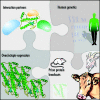The prion protein knockout mouse: a phenotype under challenge
- PMID: 19164918
- PMCID: PMC2634447
- DOI: 10.4161/pri.1.2.4346
The prion protein knockout mouse: a phenotype under challenge
Abstract
The key pathogenic event in prion disease involves misfolding and aggregation of the cellular prion protein (PrP). Beyond this fundamental observation, the mechanism by which PrP misfolding in neurons leads to injury and death remains enigmatic. Prion toxicity may come about by perverting the normal function of PrP. If so, understanding the normal function of PrP may help to elucidate the molecular mechansim of prion disease. Ablation of the Prnp gene, which encodes PrP, was instrumental for determining that the continuous production of PrP is essential for replicating prion infectivity. Since the structure of PrP has not provided any hints to its possible function, and there is no obvious phenotype in PrP KO mice, studies of PrP function have often relied on intuition and serendipity. Here, we enumerate the multitude of phenotypes described in PrP deficient mice, many of which manifest themselves only upon physiological challenge. We discuss the pleiotropic phenotypes of PrP deficient mice in relation to the possible normal function of PrP. The critical question remains open: which of these phenotypes are primary effects of PrP deletion and what do they tell us about the function of PrP?
Figures



References
-
- Aguzzi A, Heikenwalder M. Pathogenesis of prion diseases: Current status and future outlook. Nat Rev Microbiol. 2006;4:765–775. - PubMed
-
- Hetz C, Maundrell K, Soto C. Is loss of function of the prion protein the cause of prion disorders? Trends Mol Med. 2003;9:237–243. - PubMed
-
- Aguzzi A. Prion diseases of humans and farm animals: Epidemiology, genetics, and pathogenesis. J Neurochem. 2006;97:1726–1739. - PubMed
-
- Caughey B, Baron GS. Prions and their partners in crime. Nature. 2006;443:803–810. - PubMed
Publication types
MeSH terms
Substances
Grants and funding
LinkOut - more resources
Full Text Sources
Other Literature Sources
Research Materials
